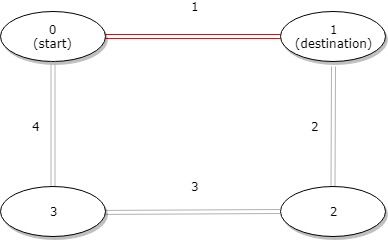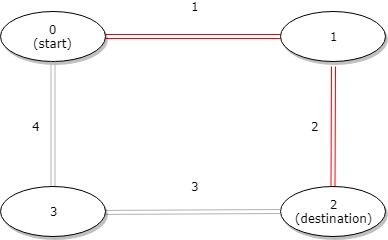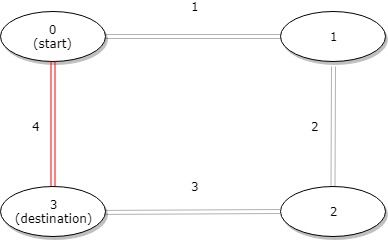A bus has n stops numbered from 0 to n - 1 that form a circle. We know the distance between all pairs of neighboring stops where distance[i] is the distance between the stops number i and (i + 1) % n.
The bus goes along both directions i.e. clockwise and counterclockwise.
Return the shortest distance between the given start and destination stops.
Example 1:
Input: distance = [1,2,3,4], start = 0, destination = 1 Output: 1 Explanation: Distance between 0 and 1 is 1 or 9, minimum is 1.
Example 2:
Input: distance = [1,2,3,4], start = 0, destination = 2 Output: 3 Explanation: Distance between 0 and 2 is 3 or 7, minimum is 3.
Example 3:
Input: distance = [1,2,3,4], start = 0, destination = 3 Output: 4 Explanation: Distance between 0 and 3 is 6 or 4, minimum is 4.
Constraints:
1 <= n <= 10^4distance.length == n0 <= start, destination < n0 <= distance[i] <= 10^4
class Solution:
def distanceBetweenBusStops(
self, distance: List[int], start: int, destination: int
) -> int:
a, n = 0, len(distance)
while start != destination:
a += distance[start]
start = (start + 1) % n
return min(a, sum(distance) - a)class Solution {
public int distanceBetweenBusStops(int[] distance, int start, int destination) {
int s = Arrays.stream(distance).sum();
int n = distance.length;
int a = 0;
while (start != destination) {
a += distance[start];
start = (start + 1) % n;
}
return Math.min(a, s - a);
}
}class Solution {
public:
int distanceBetweenBusStops(vector<int>& distance, int start, int destination) {
int s = accumulate(distance.begin(), distance.end(), 0);
int a = 0, n = distance.size();
while (start != destination) {
a += distance[start];
start = (start + 1) % n;
}
return min(a, s - a);
}
};func distanceBetweenBusStops(distance []int, start int, destination int) int {
s := 0
for _, x := range distance {
s += x
}
a, n := 0, len(distance)
for start != destination {
a += distance[start]
start = (start + 1) % n
}
return min(a, s-a)
}
func min(a, b int) int {
if a < b {
return a
}
return b
}/**
* @param {number[]} distance
* @param {number} start
* @param {number} destination
* @return {number}
*/
var distanceBetweenBusStops = function (distance, start, destination) {
const s = distance.reduce((a, b) => a + b, 0);
let a = 0;
const n = distance.length;
while (start != destination) {
a += distance[start];
start = (start + 1) % n;
}
return Math.min(a, s - a);
};function distanceBetweenBusStops(distance: number[], start: number, destination: number): number {
const s = distance.reduce((a, b) => a + b, 0);
let a = 0;
const n = distance.length;
while (start != destination) {
a += distance[start];
start = (start + 1) % n;
}
return Math.min(a, s - a);
}


